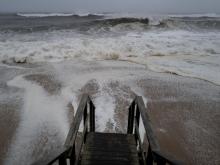- South and Midwest face potentially catastrophic rains and floods while reeling from tornadoes
- Deadly 2024 hurricanes prompt WMO to retire three names
- Body recovered in North Carolina identified as East TN man who has been missing ever since Hurricane Helene
- Report: Coastal flooding could threaten 1.4 million homes by midcentury
- Caught on camera | Tornado touches down in Missouri
Severe flooding from hurricanes connected to climate change

Flooding has been in the forefront of national news weather headlines.
Flooding devastation struck Louisiana, Mississippi, Tennessee, Nebraska, Illinois, North Carolina and New Jersey in the month of August alone. Torrential rains were sparked from tropical cyclones and blocking patterns with a warmer climate playing a big role.
Notably, Hurricane Ida made landfall near Port Fourchon, Louisiana, as a Category 4 hurricane with winds at 150 mph. This tropical cyclone moved over above-normal sea surface temperatures in the mid 80s.
The very warm water in the Gulf of Mexico was a factor that fueled a rapid intensification cycle, and Ida leaped from a Category 1 to a Category 4 hurricane within 24 hours prior to moving onshore.
The storm pummeled the Louisiana and Mississippi with about 15 inches of rain and catastrophic storm surge.
Dr. Kerry Emanuel, a professor of atmospheric science at Massachusetts Institute of Technology said, “On both theoretical and modeling grounds, we expect tropical cyclones to become more intense, but not necessarily more frequent, as our climate continues to warm. Recently, we have seen evidence of increasing intensity in satellite data. We also expect the more intense storms coupled with rising sea level to result in more coastal flooding from storm surges.”
Emanuel said most of the loss of life, injury and damage from tropical cyclones is due to water, not wind.
“Flooding is the real problem with these storms, and this occurs as much inland, usually within a few hundred miles of the coast, and it does on the coast itself,” he said. “While hurricane winds quickly diminish as the storms move inland, their rainfall can actually increase, particularly if the storm stalls.”
Hurricane Henri brought devastating flooding into New Jersey. The storm was downgraded from a hurricane before reaching New England. The National Hurricane Center warned the slow-moving storm would continue dumping heavy rains on wide swaths of the region well beyond the weekend.
With a warming climate, blocking patterns happen more often on a larger scale. Mid-August in Tennessee, a stationary boundary drove rounds of heavy rain into the town of McEwen near Waverly. Within a span of 24 hours, 17 inches of rain fell. That shattered the record rainfall of 13.6 inches set back in 1982. This record setting rainfall killed 22 people.
Tropical Storm Fred downgraded to a tropical depression and left western North Carolina underwater killing five people. There were reports of over 20 inches of rain in some places, and infrastructure damages are estimated to exceed $20 million alone across the region, according to Gov. Roy Cooper’s office.
“The people of western North Carolina took a devastating blow from Tropical Storm Fred’s flooding,” Cooper said in a news release. “Federal assistance is needed to help rebuild and become more resilient ahead of future storms.”
Warmer air is resulting in more evaporation and, ultimately, more rainfall.
“The amount of water vapor the air can hold increases 7% for each 1 degree Celsius of warming of the lower atmosphere and ocean. While we do not expect annual average rainfall to increase very much, we do expect rainfall from extreme events like hurricanes to increase at the 7% rate and see some evidence that that is happening,” said Emanuel.

